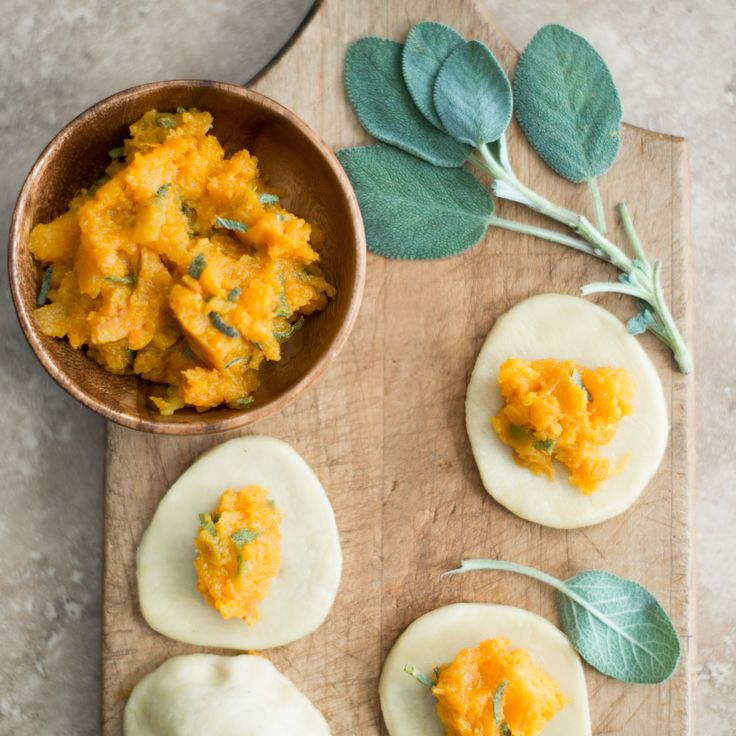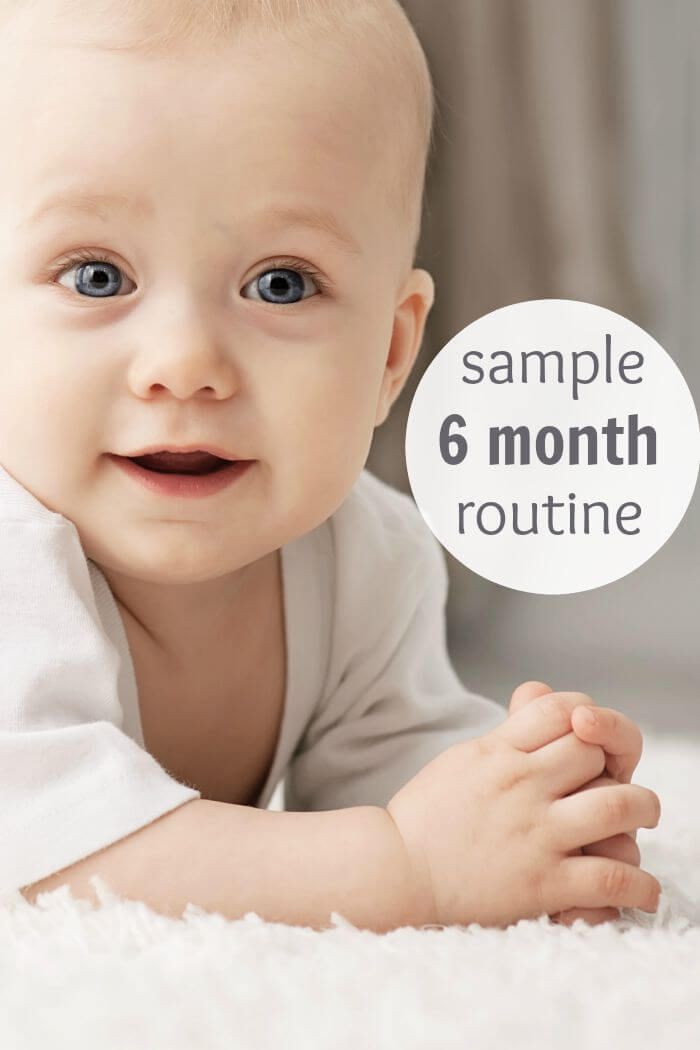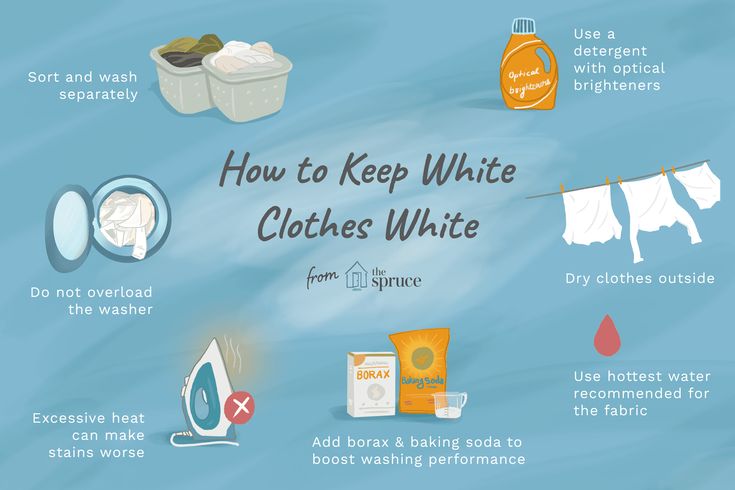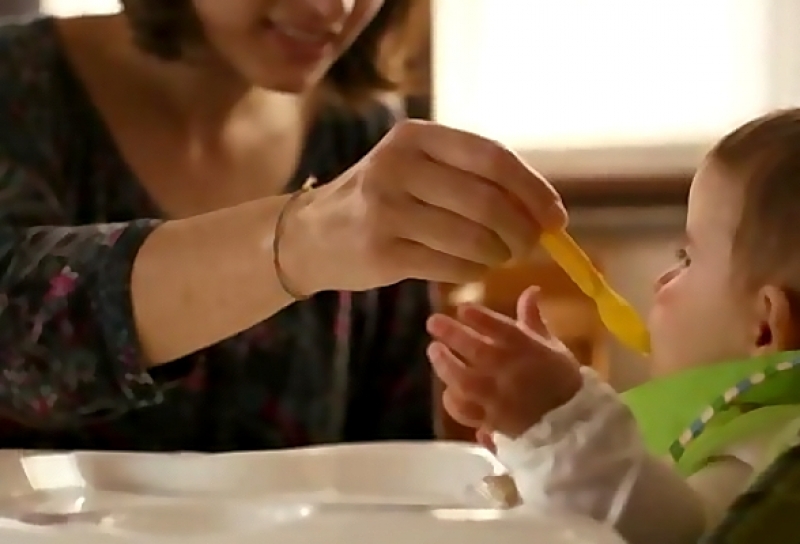How long can baby food be frozen
How Long Does Homemade Baby Food Last?
As your little one grows and develops, they will continue to reach new milestones along the way. One of the most memorable (and messy!) experiences you will have with your new baby is their introduction to baby food! Many parents prefer to make their child’s baby food at home, as opposed to purchasing pureed foods in-store.
Although the possibility may seem daunting, it can actually be quick and easy! Making homemade baby food also has tremendous benefits for your little one (and you)! Not only will your baby benefit from more variety and textures, fresh tasting food, and more nutrition, but you’ll be able to have more control over what your baby is eating and can easily keep track of the ratio of fruits and veggies their having.
Shopping trips are reduced, and buying fresh fruits and veggies in bulk to make your own baby food can produce more ounces of fresh purees than store-bought baby food jars can offer. However, without a printed expiration date on a jar, it is important to pay attention to how long homemade baby food lasts! Here are some guidelines for keeping your little one’s purees safe and fresh:
Refrigerated - 48 HoursIf you are storing your homemade baby food in the refrigerator, freshly made baby food will last in the fridge up to 48 hours. However, if you store purees in individual containers for quick, single-use servings, this storage method can be a convenient option (as it will eliminate the need for defrosting or any other extra steps).
Be sure to write the date on the containers, to ensure that they are being thrown out after the 48-hour window closes! If you do not plan to freeze your homemade baby food, we would suggest that you make the puree on a day to day, or every other day, basis. Also, never feed your baby directly from the original storage container and then re-store. Saliva and other bacteria can contaminate the food if you do so.
Frozen - 3 -6 MonthsFor optimal quality and nutrient retention, it is suggested to keep homemade baby food in the freezer for a maximum of 3 months. However, it is still safe for your baby to eat for up to 6 months. The ideal way to freeze homemade baby food is by using the Infantino Squeeze Station™.
The Squeeze Station makes the task of making homemade baby food even easier by offering an easy container for immediate use, or storage for later in the fridge or freezer. Convenience is key when you’re a mom on-the-go and the Squeeze Station is the perfect tool to help with all of your baby food needs.
Convenience is key when you’re a mom on-the-go and the Squeeze Station is the perfect tool to help with all of your baby food needs.
Another way to store frozen baby food is to put your homemade baby food in ice cube trays covered in plastic wrap, and then pop them out into freezer Ziploc bags once frozen. Be sure to label with the type of food and the date it was made. This method can help to keep track of portioning because every ice cube sized frozen baby food puree is approximately one ounce, which helps you measure how much food your baby is actually eating! You can also defrost one cube at a time, which creates less waste than traditional baby-feeding methods.
Whether you choose to refrigerate or freeze your homemade purees, you may find it convenient to make your own baby food pouches and our Squeeze Station can help with just that. Homemade baby food pouches can be stored in the fridge or the freezer, and they follow the shelf life and freshness guidelines as homemade baby food that is stored in other containers. If baby food pouches seem like the best option for your family, whether at home or on-the-go, Infantino has some great products that can help!
If baby food pouches seem like the best option for your family, whether at home or on-the-go, Infantino has some great products that can help!
You can make and store your own convenient food pouches with the Infantino Squeeze Station. It's quick and easy! Just pour in the purée and press down to fill. The non-skid base stays secure on your counter, and the soft press ensures a stable grip. Plus, the station is dishwasher safe, so clean up is simple! The Squeeze Station is perfect for homemade baby food and smoothies, as well as store-bought applesauce, yogurt, and purées. Your little one can enjoy the pouches right away, or you can store them in the refrigerator or freezer for later. These are perfect for making on-the-go feeding a breeze! The Squeeze Station also includes 10 Squeeze Pouches™.
50-Pack Squeeze Pouches™You can also purchase more squeeze pouches in packs of 50! Use the Fresh Squeezed® refill pack of pouches with the Squeeze Station™ to create homemade food pouches.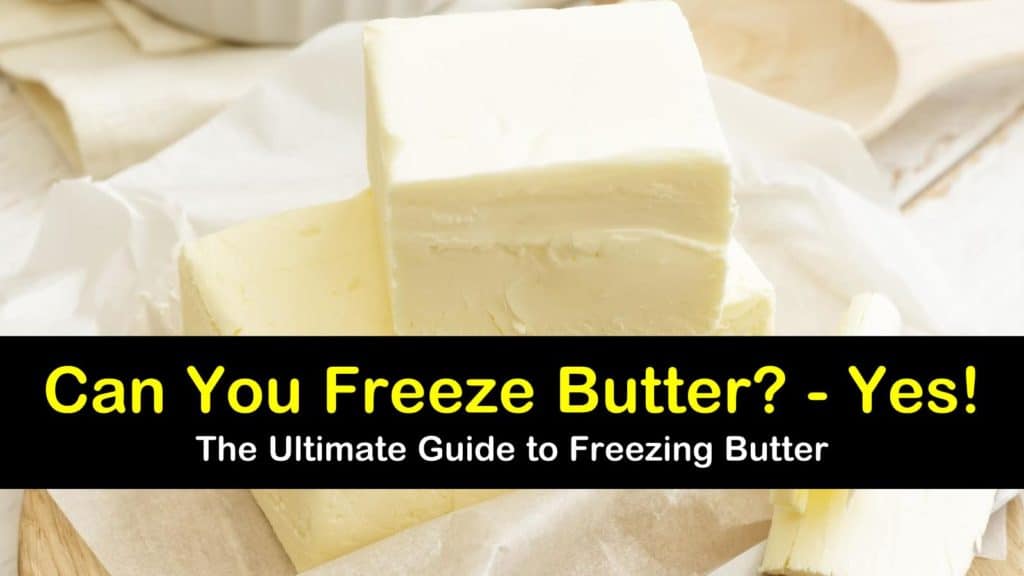 The pack includes 50 food-safe, disposable pouches, and 50 kid-safe caps. Each pouch holds up to 4 ounces of food and features a clear window to see the food inside. The rear window also has a space to write dates, name, and the food type. All of the pouches are freezer safe and BPA, PVC, and phthalate free!
The pack includes 50 food-safe, disposable pouches, and 50 kid-safe caps. Each pouch holds up to 4 ounces of food and features a clear window to see the food inside. The rear window also has a space to write dates, name, and the food type. All of the pouches are freezer safe and BPA, PVC, and phthalate free!
This environmentally friendly, reusable food pouch can also be used with homemade purees, smoothies, applesauce, yogurt and more. Use the screw top to pour in your child’s favorite snack. Perfect for The secure, screw top prevents leaks and messes. Plus, the Reusable Squeeze Pouch includes a handy clip for attaching to bags and strollers. This silicone pouch is easy to clean, dishwasher safe and BPA, PVC, and phthalate free.
We hope that these freshness guidelines will help you along your homemade baby food journey, keeping your little ones healthy, happy, and safe!
Storing Baby Food | Happy Baby Organics
AndieM.Ed., RD, LDN, CLC, RYT-200
Read time: 6 minutes
How to store homemade baby food and store-bought pureed foods
How to thaw and re-heat pureed baby food
How to help prevent bacterial contamination of baby foods
Whether you buy baby food at the market or make it from scratch, it’s important to know how to store, prepare, and reheat your baby’s food correctly and safely.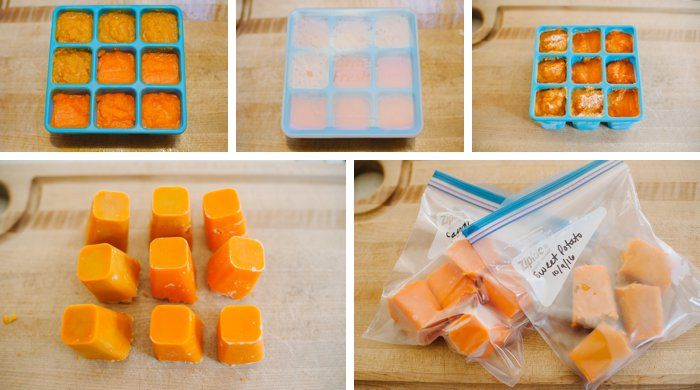 Store-bought baby food usually comes in a glass jar, plastic container, or pouch and usually does not require refrigeration or freezing before opening. These foods are manufactured to be shelf-stable, like any other pantry item (think beans, soups, or condiments). They can typically stay fresh on the shelf for 1 to 2 years, but always check expiration dates carefully.1
Store-bought baby food usually comes in a glass jar, plastic container, or pouch and usually does not require refrigeration or freezing before opening. These foods are manufactured to be shelf-stable, like any other pantry item (think beans, soups, or condiments). They can typically stay fresh on the shelf for 1 to 2 years, but always check expiration dates carefully.1
Pureed store-bought baby vegetables and fruits can stay in the refrigerator for up to 48 to 72 hours and in the freezer for 6 to 8 months.
Pureed store-bought meat, poultry, or fish can be refrigerated for 24 hours after cooking and frozen for 1 to 2 months.
Homemade baby foods will keep for 24 to 48 hours in the refrigerator and for 1 to 2 months in the freezer.
Be sure to refrigerate freshly cooked baby food within 2 hours as bacteria will start to grow at room temperature after those 2 hours are up. Note that your refrigerator should be kept at, or below, 40 degrees F.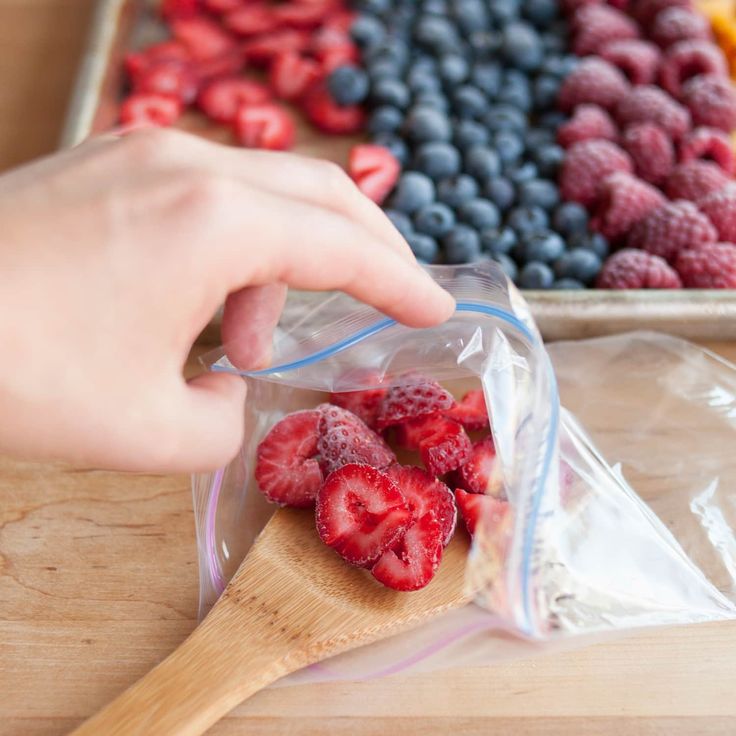 Any warmer and illness-causing bacteria can thrive and quickly multiply.3
Any warmer and illness-causing bacteria can thrive and quickly multiply.3
Want some tips on feeding your little one or on making baby food? The Happy Baby Experts are infant feeding specialists and here to help (for free!) with questions about starting solids and picky eating, as well as formula and breastfeeding. Chat now!
Can I feed baby directly from the jar or pouch?
If you feed your little one directly from the jar or pouch, all leftovers must be thrown out after the meal. Saliva from baby’s mouth gets back into the jar or pouch via the spoon, this introduces bacteria that can quickly multiply and contaminate the food. If you know baby won’t finish it all, spoon a serving in a separate bowl and feed from that. Then you can refrigerate the jar or pouch of remaining food for an upcoming meal!4
For more information, read: How Can I Make my own Pureed Baby Food?
How to warm refrigerated or shelf-stable foods and thaw frozen foods:Microwave: Warm up store-bought food directly in its glass jar or transfer the food – including previously frozen purees – into a separate glass bowl (never heat up pureed food in a plastic container or pouch).
 Reduce the microwave to 50% power (or use the defrost feature) and then warm the puree in 15 second increments. 4 Check and stir the food thoroughly each time to ensure even heating and to eliminate any heat pockets that may burn your baby’s mouth.
Reduce the microwave to 50% power (or use the defrost feature) and then warm the puree in 15 second increments. 4 Check and stir the food thoroughly each time to ensure even heating and to eliminate any heat pockets that may burn your baby’s mouth.Stovetop: Warm your baby’s store-bought food or thaw frozen baby food on the stovetop by placing the food in a small saucepan and warming on low heat until the puree is the same consistency and no longer frozen. To preserve the nutrients, heat only as much as is necessary.
Submersion Method: Thaw frozen baby food by placing the pureed cubes in a plastic bag and then inside a bowl filled with hot or warm water. This method allows for even warming but does take a little longer – figure about 10-20 minutes for the food to thaw fully. 5 Many parents also use the submersion method to thaw frozen breastmilk.
Refrigerator: Thaw frozen baby food simply by transferring it to the refrigerator.
 5 This process will take 4-12 hours so plan ahead (transferring the food the night before it’s needed to allow thawing overnight is a good rule of thumb). Homemade frozen baby food that’s been thawed can safely stay in the refrigerator for up to 48 hours. Be sure to keep thawed baby food in a sealed container to avoid contamination.
5 This process will take 4-12 hours so plan ahead (transferring the food the night before it’s needed to allow thawing overnight is a good rule of thumb). Homemade frozen baby food that’s been thawed can safely stay in the refrigerator for up to 48 hours. Be sure to keep thawed baby food in a sealed container to avoid contamination.DO NOT let baby food thaw for long periods of time on the counter at room temperature. This will allow bacteria to grow. 5
Freeze purees in ice cube trays or on a cookie sheet
Sanitize or thoroughly clean standard ice cube trays before spooning the puree directly into each cubed section. You could also cover a cookie sheet with parchment or wax paper and spoon small ‘mounds’ of puree onto the sheet to freeze.
Cover the tray with plastic wrap and place into the freezer.
Once the cubes or ‘mounds’ are solidly frozen, pop them out and store them in plastic freezer bags.
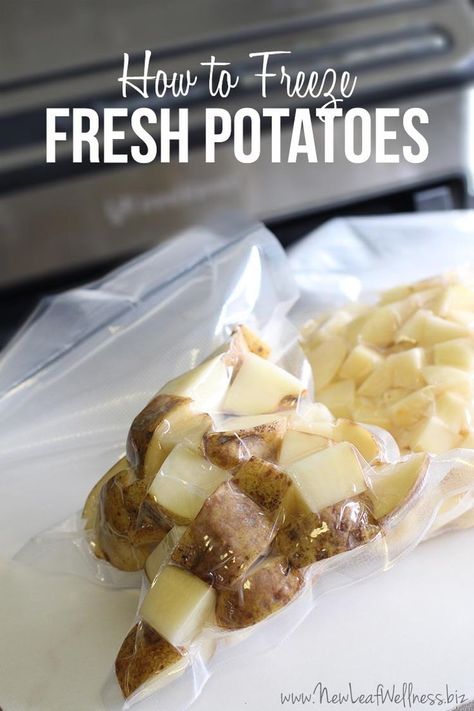
Label the bags with the type of baby food as well as the date. This allows you to use it before it expires. (Remember: store-bought fruits and veggies can be frozen for 6 to 8 months, while meats, poultry, and all home-made baby food can be frozen for 1 to 2 months).
When your baby is ready to eat, grab an individual portion of the cubes you want to use and thaw!
Ice cube trays are not only convenient, they are also incredibly helpful in portioning out homemade baby food. The cubes are roughly 1 ounce each, so you can easily measure the amount of food your baby is eating and thaw small portions at a time to reduce waste.
Do not freeze food in glass containers
Glass baby food jars (or any glass container) are not meant to be frozen. Frozen glass can burst or cause tiny fractures in the glass leaving behind microscopic shards that you may never see.Freeze baby food in safe “ok to freeze” plastic containers instead.
Consider a deep freezer if you want to store purees long-term
For best results, frozen foods should remain at a constant sub-zero temperature. A deep freezer is better equipped to handle this temperature control as opposed to your regular freezer, which may fluctuate with you opening and closing the door often.
Throw away leftover food that’s already been reheatedYou cannot reheat (or re-freeze) baby food more than once, so once you’ve thawed a frozen puree, toss any leftovers. This rule also applies to breastmilk. So if you’re using breastmilk to thin out your homemade baby food purees, add the milk while it’s fresh!
Read more: Safe Storage of Pumped Breastmilk
You can also use formula too thin a puree. Do not freeze formula in its original can or bottle, but once mixed into a puree it’s ok to freeze. Freezing formula causes a separation of the fats from the liquid, which may negatively impact the texture and quality.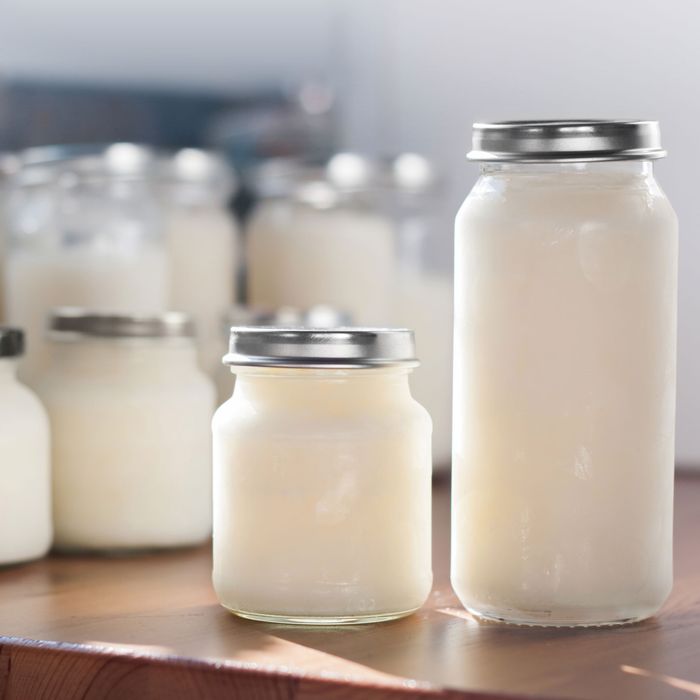 6
6
We know parenting often means sleepless nights, stressful days, and countless questions and confusion, and we want to support you in your feeding journey and beyond.
Our Happy Baby Experts are a team of lactation consultants and registered dietitians certified in infant and maternal nutrition – and they’re all moms, too, which means they’ve been there and seen that. They’re here to help on our free, live chat platform Monday through Friday, from 8am–6pm ET. Chat Now!
Read more about the experts that help write our content!
For more on this topic check out the following articles
How do I Choose Store Bought Baby Food?
Food Safety for Babies and Toddlers
Everything You Need to Know About How to Prepare and Store Infant Formula
Avoid Giving Your Child Too Much Sugar And Salt
How to freeze baby food - Encyclopedia Baby food
Levchuk Victoria ©Levchuk Victoria ©
Knowing how to freeze baby food, you can cook and store whole batches of homemade food for a child, because this is a real find for busy parents.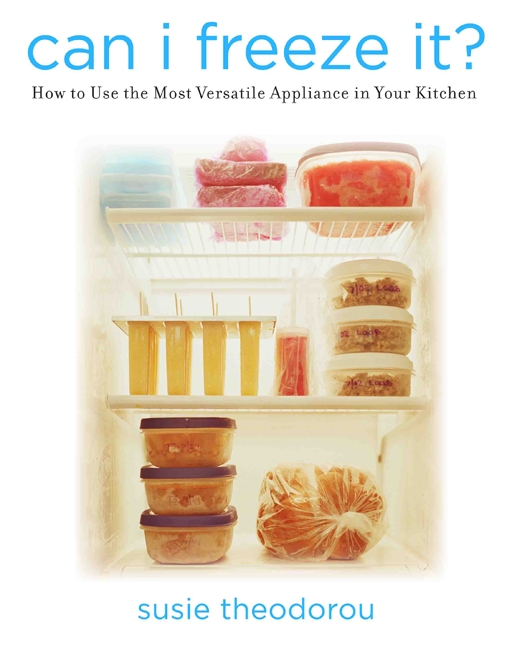
Table of Contents:
There are several ways to freeze baby food - they all work equally well - but may take up different amounts of freezer space.
By all means …
… homemade baby food must be prepared and then cooled as quickly as possible to prevent bacterial growth. Any food left at room temperature for more than two hours is not safe for a child to consume and should be thrown away.
To cool cooked food quickly, you can try putting it in a shallow container - you can even dip the container in a pot of cold water to help speed up the process.
How to freeze baby food - Method 1
Thoroughly clean the ice mold and the spoon that will be used in filling each section. An ice cube tray with a resealable lid is ideal as it protects food from frostbite or picking up any odors from the freezer. If there is no mold with a lid, you can cover with food-safe plastic wrap. Some people use foil, although we don't recommend it as some of the foil will remain in the food!
Place the filled ice cube tray in the freezer, and - once completely frozen - place them in ZIP bags that take up less space in the freezer.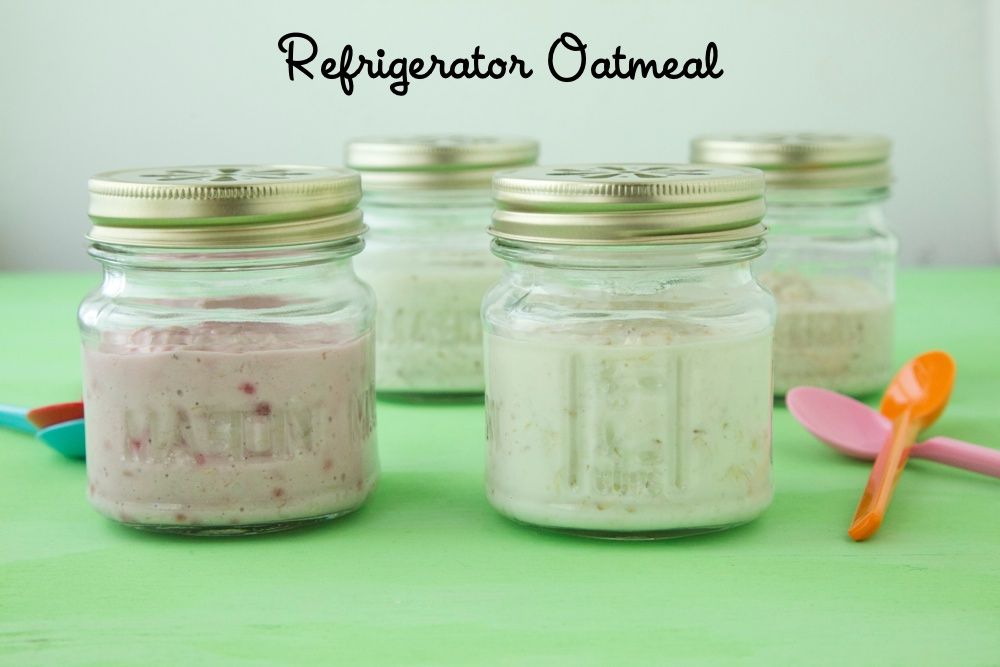
This method produces small portions of baby food that are ideally sized - typically around 30 grams or so. One cube per meal may be enough for a child to start with, but as they grow, you may need to increase the number of cubes at a time or increase the ice cube tray.
You can also make many different flavors of baby food by mixing and matching different fruit and vegetable cubes, for example, the combination of cubed apple puree with cubed carrot puree, delicious!
Which ice mold should I choose?
Some ice cube trays are specifically made for baby food and do not contain potentially hazardous chemicals - but you can use a regular ice cube tray, or you might be advised to try a silicone mold, or even stainless steel trays, although the regular plastic version will do. if there is confidence in the quality of the workmanship.
How to freeze baby food - Method 2
Same as method 1, since the process of freezing baby food is the same, only silicone cupcake molds are used instead of an ice mold! Their flexibility makes it easy to remove food portions - plus, of course, their use is beneficial when the baby starts to eat more baby food!
How to Freeze Baby Food - Method 3
If no suitable freezer containers are available for baby food, baking paper can be used (although a little more freezer space will be needed initially).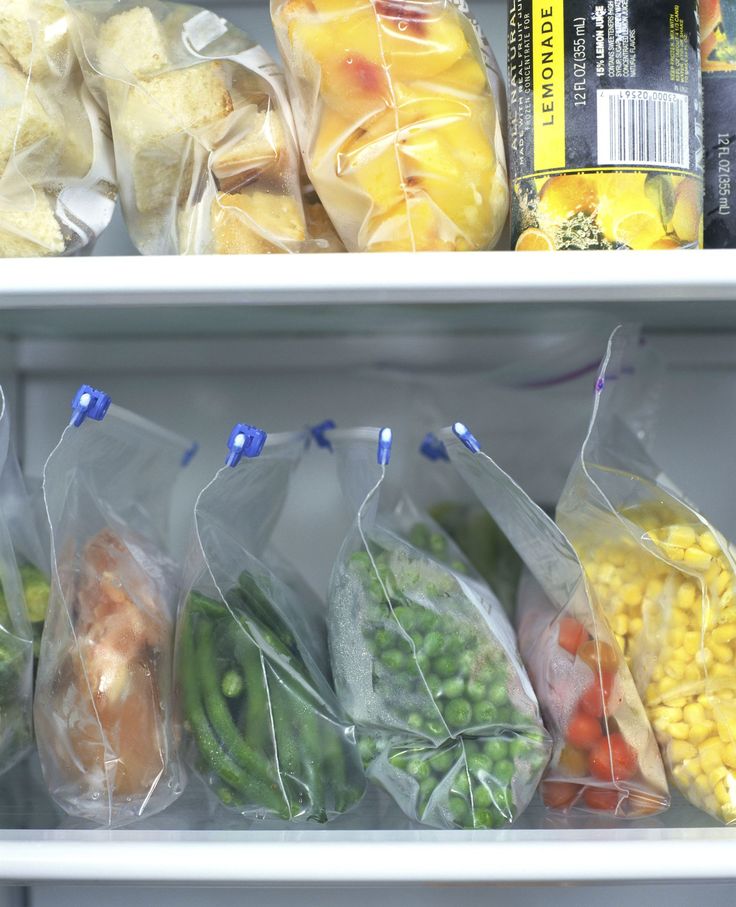
Simply spoon the cooked baby puree onto the baking sheet to form small mounds (though note that this will not work if the puree is too thin). We cover the baking paper with cling film, freeze, and then mix the servings of food into bags, as before.
How to Freeze Baby Food - Method 4
Another good way to freeze homemade baby food is to divide the puree into freezer glass jars and place them in the freezer.
However, please note that you should never freeze baby food in glass jars unless the jar manufacturer has specifically stated that freezing is safe and possible.
Jars that are freezer safe must be properly labeled and distinguished from other tins (including commercial baby food tins) that are not strong enough to withstand the expansion of food that occurs during the freezing process.
This means that the jar may burst or, even worse, there may be small microcracks that cannot be seen with the eyes, but which will allow tiny pieces of glass to get into the baby's food.
How to Freeze Baby Food Method 5
Probably the most popular way to freeze homemade baby food is to use freezer trays or jars for baby food, there are so many options to choose from!
Manufacturers, recognizing the growing trend of parents to freeze baby puree, offer special forms of baby food that make life easier, well, because there is a lid! What's more, these molds are free of potentially harmful chemicals, which is something some plastic trays for general consumption are guilty of.
Tracking the finished product
Most types of baby food - especially purees - freeze perfectly. Sometimes you will have to experiment with texture, since the freezing process itself consists in the fact that the water in the product expands when it freezes, destroying the cell walls. This is especially noticeable when the whole food is frozen, for example a frozen banana will be very soft when thawed.
To reduce the hassle of freezing baby food here are some helpful tips.
 ..
.. - Do not puree too thin before freezing. Keep in mind that many foods become watery when thawed (especially fruits and vegetables), adding extra liquid before freezing will then add too much cereal to thicken!
- Herbs and spices tend to lose their flavor in the freezer. If a baby food recipe calls for them, it is best to add them after after the food is defrosted, just before heating.
- Baked foods - like homemade nuggets or fish fingers - are best frozen when almost cooked but not fully done. This is because the structure of the food when frozen and thawed can behave negatively.
— When freezing yogurt, remember that it may be too thin when defrosted. Sometimes stirring it well is enough to solve this problem - but in some cases, the resulting yogurt is too thin to eat with a spoon, so such yogurt can be used in a smoothie!
- A good result is obtained from freezing rice and oatmeal, which is good if the morning is like a nightmare and there is no time to organize a full breakfast.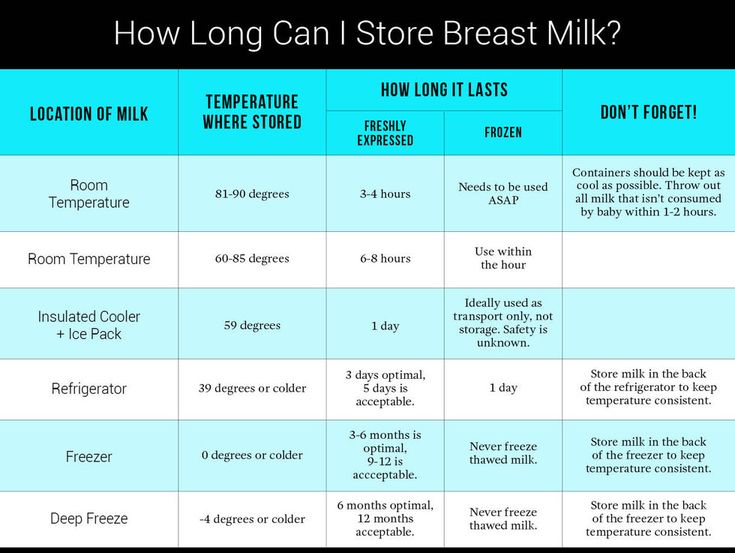 Only cereals should not be made too thin before they are frozen .
Only cereals should not be made too thin before they are frozen .
- Many fruits - especially apples and pears - can look very brown when frozen and thawed. This discoloration is a natural and harmless result of the fruit being exposed to air, but if it's a concern, mixing lemon juice and fruit puree before freezing can be a solution. Please note that citrus fruits can cause an allergic reaction in babies, so you can use it with a changed color!
- If you want to make your own stock of vegetable or meat broth, which is convenient, you just need to prepare a large batch at a time and freeze. It's worth trying freezing in ice cube trays or baby food trays, as discussed above - then the ideal size of small portions will be in the freezer to use as needed.
- If baby food has been frostbitten, fortunately food safety is not affected - just thaw and then cut or spoon away the affected areas.
How to defrost baby food
The safest and easiest way to defrost baby food is to put it in the refrigerator overnight before feeding.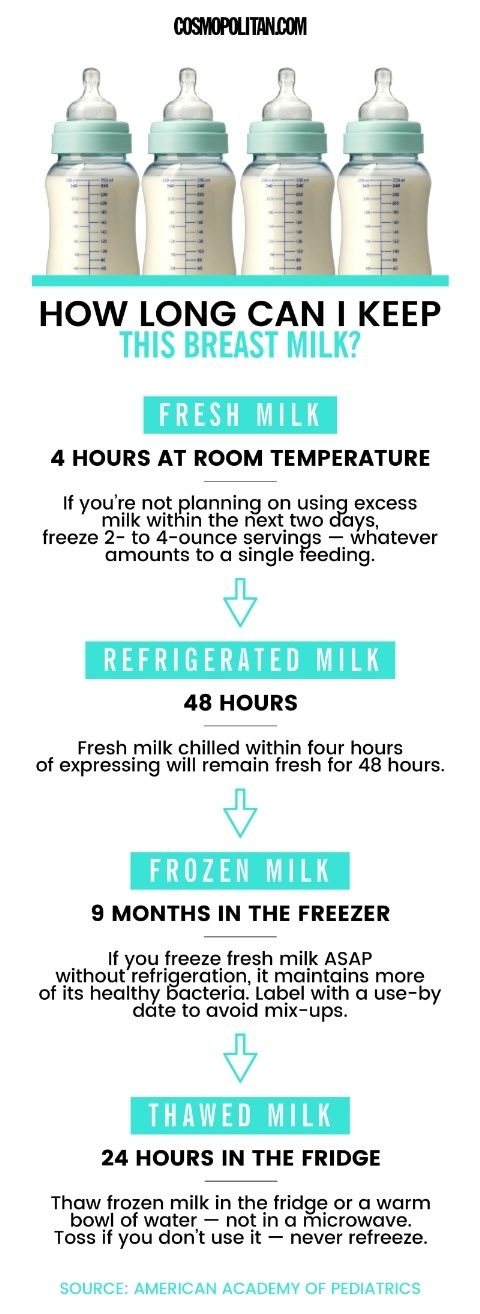 Frozen baby food cubes take 8-12 hours to thaw in most refrigerators. Thawed baby food should be used within 24 hours.
Frozen baby food cubes take 8-12 hours to thaw in most refrigerators. Thawed baby food should be used within 24 hours.
Never, never refreeze defrosted baby food as this creates a risk of food poisoning for the baby.
We are not afraid and add me to VK and Odnoklassniki, Instagram!
Like this article? Subscribe to site updates
"Encyclopedia Baby Food"!
Don't forget to bookmark us! (CTRL+SHIFT+D) Subscribe to the site, comment, share in social networks.
On our site Encyclopedia Baby Food there is useful information on the nutrition of your children, which is useful for everyone, and we update the site "Encyclopedia Baby Food" constantly and try to search and write only excellent, verified and necessary information for you and your children.
Disclaimer No. 1: It must be understood that the author of the articles on the Baby Food Encyclopedia website is not a medical staff, “I am not a doctor.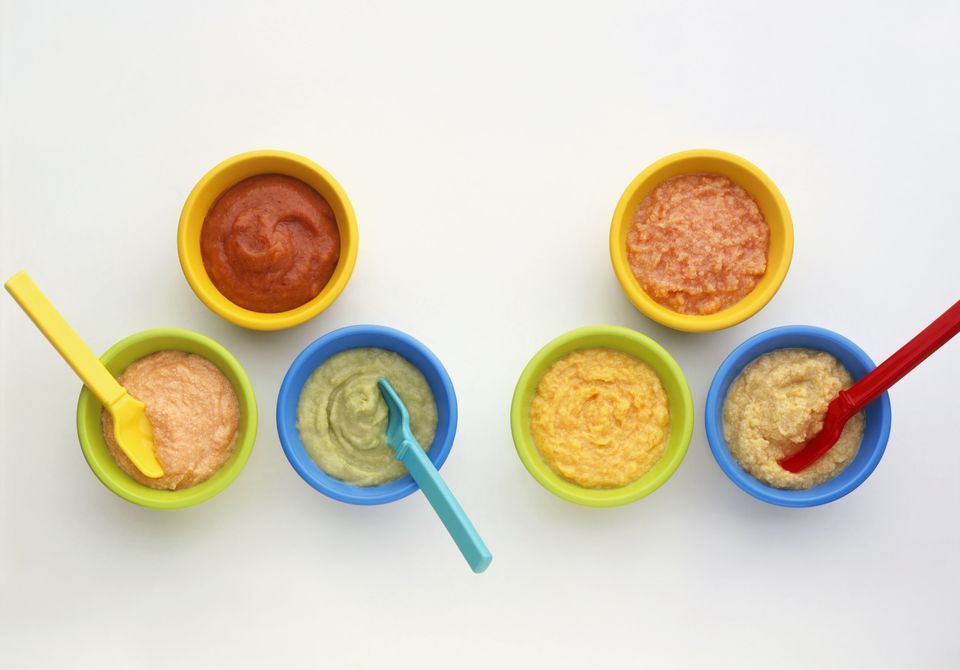 ” The information I share is based on my own experience. My goal is not to teach you how to eat or feed your child, but to talk about how we did it, what new things I learned or read. This expands the picture of Baby Food knowledge, gives you a glimpse of the whole process so you can decide if you like it or not.
” The information I share is based on my own experience. My goal is not to teach you how to eat or feed your child, but to talk about how we did it, what new things I learned or read. This expands the picture of Baby Food knowledge, gives you a glimpse of the whole process so you can decide if you like it or not.
Disclaimer No. 2 : However, the above does not replace visiting a pediatrician. Before you start complementary foods, you need to get his professional opinion on the best way to introduce new foods for your baby. I also draw your attention to the fact that you need to look at the original date of the published articles, because some of the "best practices" may have changed. Always check with your child's pediatrician about complementary foods and their health.
Disclaimer #3: Keep in mind that every family is unique, every situation is also completely unique. There are no universal solutions. Only you can find what works best for you.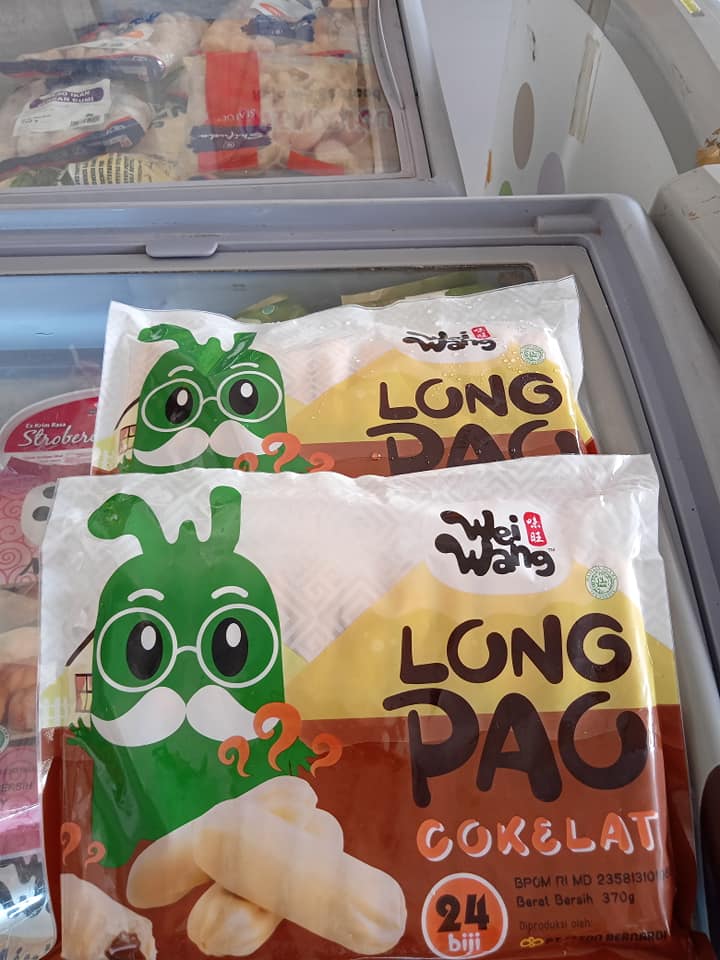 Certain goals require certain sacrifices and priorities - not everyone wants to make those choices, and that's GREAT! Just know what you want to achieve, and be ready to get to work, putting the best of your strength!
Certain goals require certain sacrifices and priorities - not everyone wants to make those choices, and that's GREAT! Just know what you want to achieve, and be ready to get to work, putting the best of your strength!
Disclaimer No. 4: On the Encyclopedia Baby Food website, photos from books on baby food with attribution are used to better understand the information (Article 1274, paragraph 1, part four of the Civil Code of the Russian Federation). Literature on baby food is found in the public domain on the Internet.
Apricot puree with chicken
Banan-global puree
Banana puree
borsch
Bousse broth with peas and rice
Botterbrod with kolrabi
Rapid dessert
Ground
Spring salad with green Buckwheat porridge with apricots
Buckwheat porridge with banana
Buckwheat pilaf
Children's sausage
Children's milk porridge with banana
Children's vinaigrette
Children's ketchup
Children's cucumber salad
Children's salad Olivier
Children's porridge biscuits
Children's puree of strawberries, bananas, yellow cherries, yoghurt and biscuits with cereals
Children's puree with cottage cheese and fruits
Homemade yeast bread with flaxseed flour
Homemade cheese
Homemade pizza
5 Breakfast outside Kohlrabi appetizer
Roasted cauliflower
Roasted carrots
Roasted carrots and cherries with millet
Winter salad with Jerusalem artichoke
Cabbage with white beans
Cabbage salad like in a canteen
Mashed potatoes
Quinoa and pumpkin porridge
Quinoa porridge
Breakfast cereals
Quinoa and apple
Strawberry puree
Strawberry puree with banana
Strawberry compote
Wild apple and raspberry compote
Thermo-steamed fruit compote for children 8 months
Corn porridge
Corn porridge with pear
Corn porridge with pumpkin
Corn porridge with pumpkin and carrots
Corn porridge with apple and carrots
Chicken liver in the oven
Chicken cutlets with carrots
Chicken with carrots, sweet peppers and potatoes
Navy pasta
Pasta with orange sauce
Gremolata pasta
Muffins with vegetables and egg
Jacket new potatoes
Vermicelli milk soup15 Carrot puree
Carrot-rice casserole
Carrots with chicken
Fly agaric from eggs and tomatoes
Meat envelopes
Homemade Tarragon drink for children
Vegetable puree from cauliflower and carrots
Vegetable soup with corn semolina
Vegetable soup with cheese and corn semolina
Vegetable soup with spinach
Vegetable puree soup with bell pepper
Oatmeal porridge
Pollock fritters
Hot yogurt fritters
Omelet cauliflower 90 in a bag
Spinach and Cheese Omelette
Omelet Pancake
Peach Puree
Baked Apples 7 months +
Zucchini and Carrot Pie
Zucchini Pie
Rice and Zucchini Pie
Fish Pie
Fish and potato pie
White cabbage pizza
Lavash pizza
Zucchini, tomato and sausage pizza
Tomato and olive pizza
Spinach pizza
Rabbit pilaf
Chicken pilaf with green peas and corn Puree 9055 and cherries
Banana, cottage cheese and porridge puree 4 cereals
Broccoli (cauliflower) puree
Broccoli, courgette and cauliflower puree
Blueberry puree
Pear puree
Pear and banana puree
Pear and banana puree, baked
Pear and pumpkin puree 7 months +
Pear, pumpkin and peach puree
Pear, apple, plum and prunes puree
Blackberry puree
Turkey puree
Zucchini puree 90 zucchini and broccoli
Zucchini, carrot and potato puree
Quinoa and banana puree
Quinoa and carrot puree
Quinoa, banana and carrot puree
Quinoa, squash and carrot puree
Quinoa, peach and raspberry puree
quinoa, cauliflower, apple, peas and mint
Quinoa, apple, pear and raisin puree
Quinoa, apple, carrot puree
Rabbit, broccoli and cauliflower puree
Chicken, carrot, potato, apple and pea puree
Raspberry, cherry and banana puree
carrots
Carrot and apple puree
Carrot, potato, broccoli puree with cheese
Carrot, potato, apple and quinoa puree
Carrot, pumpkin, apple and prunes puree
Carrot, apple and potato puree
Turnip and carrots
Plum puree
Cottage cheese, strawberry and banana puree
Pumpkin puree
Pumpkin and banana puree
Pumpkin and squash puree
Pumpkin and apple puree
Pumpkin, apple and banana puree
Cauliflower and broccoli puree
Cauliflower puree and potatoes
Cauliflower and rice puree
Cauliflower and apple puree
Cauliflower, green peas and squash puree
Cauliflower, turkey and potato puree
Cauliflower, potato and squash puree
Cauliflower, carrot and broccoli puree
Cauliflower, carrot, cheese and rice puree
Cauliflower, apple and courgette puree
Zucchini puree
Zucchini and potato puree
Zucchini, carrot and apple puree 90 cherries
Blueberry puree
Prune puree
Apple, pumpkin, carrot and some curry puree
Apple and pear puree
Apple and strawberry puree
Apple, strawberry and cherry puree
Apple, peach and banana puree
Carrot and pumpkin puree
Cottage cheese and banana puree
Turkey, potato and carrot stew
Zucchini, carrot and broccoli stew
Fish, potato, carrot and broccoli stew
Rice porridge
Whole grain rice porridge
carrot
Rice porridge with pumpkin
Rice porridge with apples
Rice porridge with apple and pear
Rice porridge with apple and pumpkin
Fish cakes with vegetables
Semi-cooked fish
Fish meatballs with ketchup
Baby Fish Soup
Salmon and Celery Fish Soup
Carrot and Kohlrabi Salad
Chickpea Salad
Chickpea and Cabbage Salad
Lazy Soup
Creamy Kohlrabi Soup
Oatmeal Smoothie 90 Sauce Pot
Cheese Pizza
Pea and Bacon Soup
Baked Vegetable Soup
Kohlrabi Soup
Salmon Soup
Cauliflower Soup
Turnip Potato Soup
Meatball Soup for the Picky Eater
Kohlrabi soup with green apple
Rabbit, pumpkin, potato, broccoli and cauliflower soup
Beetroot soup
Pumpkin soup with mushrooms
Broccoli and celery soup
Soup/stew Pork with Potatoes and Carrots
Cheese Pasties
Pumpkin Cheese Sauce (Annabelle Carmel Recipe)
Buzz Lightyear Sandwich
Pumpkin Apple Puree
Pumpkin Apple Juice
Pumpkin Cake
Pumpkin Soup9 Puree
Fruit Salad 7 Bread lavash
Cauliflower with cheese
Linden and thyme tea
Experimental noodle soup with lentils
Apple puree
Apple juice
Is it possible to freeze baby puree in a glass jar + at home, secrets 9014 9014 Frozen puree - harvesting vegetables and fruits for children for the winter
Every mother wants to feed her child with good nutrition so that the baby receives all the necessary vitamins and microelements. In summer, this is easy to do, there are many fresh vegetables and fruits, and in winter you need to come up with alternative options. A large number of manufacturers offer a wide range of ready-made baby purees, but are they really that good? After all, we do not know exactly what is in their composition, whether the technology of preparation and storage of products is correctly observed. And even if everything is fine there, then such a puree consists not only of vegetables and fruits, but at least sugar and thickeners are added there. So how to be? The answer is simple - make your own puree and store it in the freezer. You can freeze in the form of mashed potatoes absolutely any fruit, vegetable or even meat that a child can eat.
In summer, this is easy to do, there are many fresh vegetables and fruits, and in winter you need to come up with alternative options. A large number of manufacturers offer a wide range of ready-made baby purees, but are they really that good? After all, we do not know exactly what is in their composition, whether the technology of preparation and storage of products is correctly observed. And even if everything is fine there, then such a puree consists not only of vegetables and fruits, but at least sugar and thickeners are added there. So how to be? The answer is simple - make your own puree and store it in the freezer. You can freeze in the form of mashed potatoes absolutely any fruit, vegetable or even meat that a child can eat.
Freezing fruit purees for children
Summer brings us a lot of various fruits and vegetables. They are rich in vitamins, nutrients, fiber and sugars. And I want to stock up on these gifts for the whole winter. The most useful way to prepare food is freezing.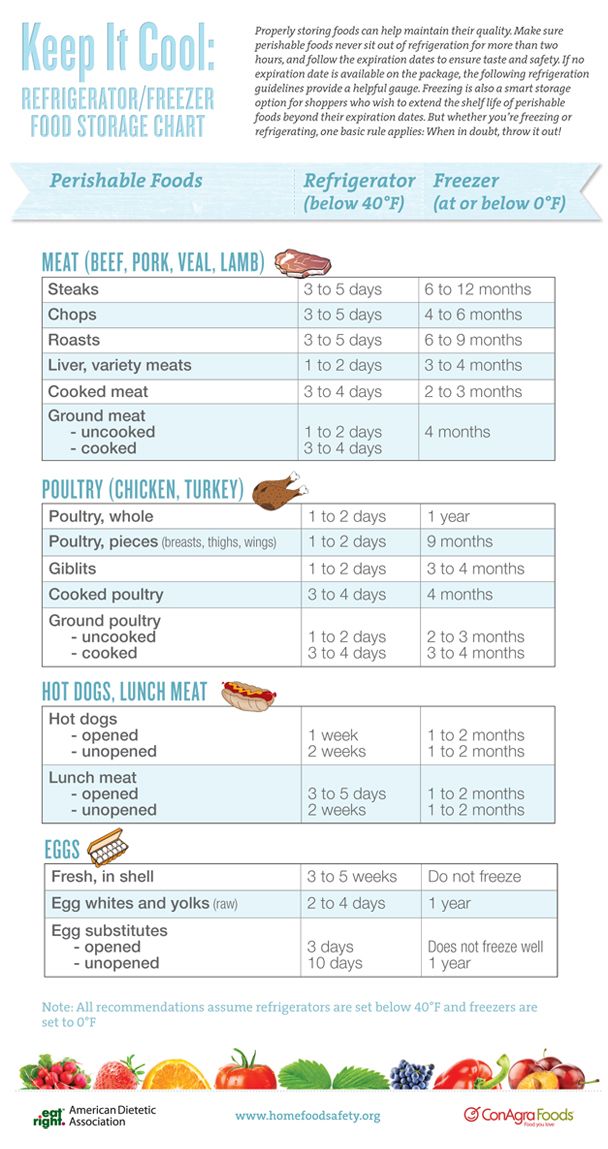 Jams and compotes from fresh berries and fruits contain a lot of sugar, they are not recommended for children under one year old.
Jams and compotes from fresh berries and fruits contain a lot of sugar, they are not recommended for children under one year old.
How to freeze fruits correctly? First, thoroughly wash pears, apples, peaches, plums - everything that you plan to freeze with warm water and soap. Then cut into small pieces and lay out on paper or a clean cloth. In no case do not dry the fruits on a newspaper - they will absorb elements harmful to the body. When the pieces are dry, put them in bags. Count each package so that frozen food can be used immediately. For example, cook compote, make mashed potatoes so that you don’t have any excess. Re-frozen and thawed fruits lose almost all vitamins.
You can also freeze ready-made fruit puree. Take a product of industrial production or made by yourself. Prepare as many yogurt cups or baby food jars as possible. Fill all containers with fruit puree and place them in the freezer. At a temperature of -18 degrees, they can be stored there for up to 3 months. Then fruit purees begin to lose vitamins. Although even after six months of storage they will be tasty, but, unfortunately, they are no longer so useful. Therefore, for feeding children under one year old, it is better to use freshly prepared or recently frozen jars of fruit puree.
Then fruit purees begin to lose vitamins. Although even after six months of storage they will be tasty, but, unfortunately, they are no longer so useful. Therefore, for feeding children under one year old, it is better to use freshly prepared or recently frozen jars of fruit puree.
In order for the puree to thaw properly, never put it under hot water. It is better to pull out the jar in advance so that by the time the baby has lunch or dinner, it is completely defrosted. You can warm the puree in a water bath or in a microwave oven, after transferring it to a suitable dish. Before you give your child food, be sure to try it yourself! Perhaps there were ice cubes in the puree. Or, conversely, you overheated it, and now it burns your mouth.
Although modern household appliances allow you to keep many products frozen for a long time, it is better to use fresh products for feeding babies. After all, it is not difficult to make mashed potatoes immediately before eating. And in winter, if you are afraid to feed your child with imported fruits, you can buy industrial-made mashed potatoes. It is manufactured and packaged in accordance with all quality standards. And it contains all the nutrients and vitamins that are so important for the health of your crumbs.
It is manufactured and packaged in accordance with all quality standards. And it contains all the nutrients and vitamins that are so important for the health of your crumbs.
Freezing vegetable puree
Most often mothers prefer to freeze seasonal vegetables such as zucchini, pumpkin, rhubarb, celery, green peas, cauliflower, broccoli, spring carrots, spinach. In order to freeze mashed vegetables, you must first bring these same vegetables to readiness. In this case, stewing vegetables is most suitable, this allows you to save more vitamins than boiling. It is necessary to cook each vegetable separately and strictly observe the cooking time, so the zucchini will be ready in 15 minutes, and carrots or cauliflower will need 7-10 minutes more. You can also add pre-cooked meat to vegetables, children love this puree very much. Immediately after cooking, while still hot, it is necessary to turn the vegetables into puree using a blender or by rubbing through a sieve, put them in a clean, dry dish and send them to the freezer.
Frozen mashed potatoes
Another option is to freeze mashed potatoes . It can be topped with honey, maple syrup, or other sweeteners. You can also use it as a filling in potato casserole, bread, cookies, puddings, brownies or potato pie.
- Follow the baked potato method to the third step. Then take the cooled sweet potatoes out of the oven, remove the skins and place the flesh in a large bowl.
- Whip sweet potatoes until smooth. Add 1 tablespoon of lemon juice for every 500 grams of sweet potatoes. Lemon juice helps prevent browning, but it's not necessary.
- Pack the sweet potato mix into bags and flatten the bag to remove as much air as possible before placing it in the freezer.
See also: Five main sauces
Eating frozen baby puree
or vegetable oil and you can eat.
Fruit puree is simply enough to defrost at room temperature, without cooking. Fruits and vegetables in the form of puree are successfully combined with various cereals, cottage cheese and kefir and make these dishes more attractive for little gourmets.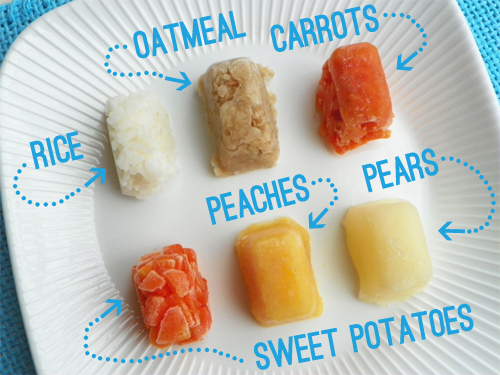
See video: How to make pumpkin puree
Simply thaw fruit puree at room temperature, without cooking. Fruits and vegetables in the form of puree are successfully combined with various cereals, cottage cheese and kefir and make these dishes more attractive for little gourmets.
Shelf life of mashed potatoes
Potatoes please with taste, benefit only when freshly prepared. Ideally, the housewives cook it at a time. As it cools, after the refrigerator, the consistency changes. The tender mass thickens, freezes. It is difficult to gain a steep mass, lumps form. Taste also changes. Only sometimes the dish is still prepared in advance, remains after the holidays. Have to store.
Where do you store mashed potatoes?
Refrigerator Freezer
Suitable utensils:
- enamel pots;
- glass, ceramic containers;
- plastic food bowls.
Not suitable:
- oxidizing packaging;
- polyethylene;
- open containers.
It is advisable to cool the excess immediately and transfer it. Don't leave mashed potatoes in the bottom of a large pot. It will dry up and change. We select a container of a suitable size. It is important to have a tight lid. Instead, it is allowed to stretch the cling film.
Vegetable mashed potatoes can be stored in the refrigerator for up to three days. When adding butter, milk 48 hours. In room conditions, 6 and 12 hours, respectively.
Refrigerated
The official shelf life for plain mashed potatoes in the refrigerator is 72 hours or three days. During this time, the vegetable dish will be nothing.

